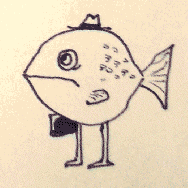Hayao Miyazaki's latest extraordinary motion picture event* is apparently leaving most of the viewing public highly satisfied. This is disturbing. The movie is horrifying. It's about a
carnivorous fish-girl that unleashes the raw power of the Cambrian Era onto the world. We're furthermore forced to acquiesce to her understanding of the events, with no regard for the esteemed Liam Neeson (I saw the dub) – not only is she five, but she's also, quite literally, lived in a bubble her entire short life.
First thing is first – Liam Neeson is a wizard. This is evident from his part as Qui-gon Jinn in the 4th/1st† Star Wars movie, a role which is paternal and also in keeping with his being a wizard-father in Ponyo.
But what Liam Neeson
isn't is an evil wizard, as his ungrateful, man-eating daughter states. And I mean man-eating literally, not sexually – they're five, please – if you didn't see the link where she licks the child's blood then you go back and click on it now, cause it's awesome. Don't look at me askance for making crass jokes about the movie, either. I was accused once for doing a set design that had a phallic fixation, but like, the play was about male dominance. Likewise, this movie has lots of reproductive imagery, to put it demurely.
Liam Neeson can't be an evil wizard, furthermore, because he's really David Bowie, so if anything he's really just a space alien (again, Star Wars bears me out in this). There's no single image that creates an exact corollary, but if you look at a picture of Liam Neeson (which, for some reason, you'll find under
Fujimoto), and you Google pictures of
David Bowie, I know you'll get three or four pictures to back this up.‡
At worst Neeson is being an overprotective father, but frankly that's very understandable. His wife abandons him and leaves him with... like, 100 children? How many evil fish-girls are swimming around in that bubble thing in his house? 100, right? 200? Tons of kids. And he's a long-haired environmentalist who doubles as a space-alien rock star – ie. a very busy man – who has to feed magical regents to prehistoric fish and make sure he doesn't get the bends while zooming around on his strange decapitated pleisiosaur boat. I mean, poor guy; in addition to all the stresses of an active life, he's the poster child for "outdated."
His daughter, furthermore, is causing all these natural disasters. The flooding of the world, the unleashing of the genesis of life. And she has the gall to fall asleep after doing all that; I'd be an angry dad, too, with the moon coming down on my head. Especially if I only found out about that ten minutes from the end of the movie. "Oh yeah, in addition to massive tsunamis and catastrophic rising sea levels, the moon is falling on our heads and this needs to be resolved in ten minutes."
Placoderms, might I add, are terrible, carnivorous creatures that make sharks blush, and I think I saw one or two of those swimming around during Ponyo. I like reading science articles on Wikipedia, because you learn terms like hypercarnivorous apex predator. That thing's going to kill you! So, okay – maybe we don't have to worry about Dunkleosteus, because Liam Neeson's all about the Cambrian Age and that's the Devonian (personal favorite, love the Devonian), but there's some big fuck-off fishes in there.
Oh man, I'm getting distracted, but this is great – America's so awesome, we don't even use the same system of measurement for
geological ages. Geology is also awesome, because it's all about EVENTS. There are lots of events in Geology, and I can guarantee you they're way more meaningful than Disney's extraordinary motion picture events.

* Vomit, Disney. I'd link to the American trailer, but it seriously makes me ill, like in my stomach, and ears, and I enjoyed my lunch just fine, but I only want to enjoy it once. Let us instead appreciate the elegance of the
French trailer.
† You have to know Jedi metaphysics to understand how to properly describe the numbering of those movies. It's like Final Fantasy games – you can't make
a sequel to a number in a sequence, I'm sorry.
‡ I know of course because I did it already, as you can see from all the links.














